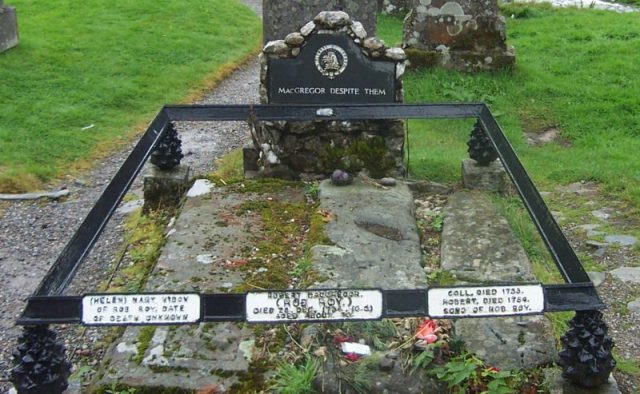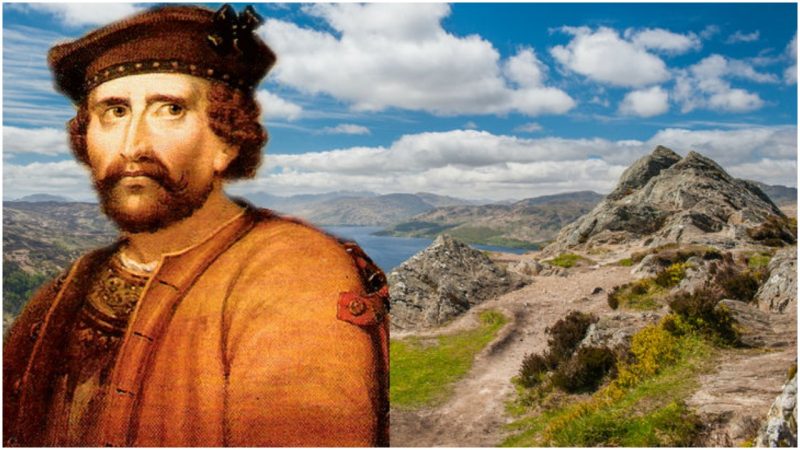A famous man is Robin Hood, The English ballad-singer’s joy! And Scotland has a thief as good, An outlaw of as daring mood; She has her brave ROB ROY! Then clear the weeds from off his Grave, And let us chant a passing stave, In honour of that Hero brave!
In this way, the romantic poet William Wordsworth begins his poem in dedication to Robert MacGregor as part of his Memorials of a Tour in Scotland in 1803. MacGregor was a man whose acts and deeds in 18th century Scotland earned him a reputation as a daring, gallant outlaw. He is celebrated simply as Rob Roy “the Scottish Robin Hood,” a fascinating and valiant hero.
Sir Walter Scott praised him as well, in his historical novel Rob Roy (1817) that lauded his great dedication to the Highlands way of life and his country. Years later, in 1953, director Harold French, filmed Rob Roy: The Highland Rogue based on Lawrence Edward Watkin’s screenplay and some well-known facts about his life, and in 1993, Liam Neeson, starring alongside Jessica Lange and John Hurt, portrayed Rob’s life once more in Michael Caton-Jones’s movie named after the character in question, Rob Roy.
Although he is depicted as a hero and a true legend in Scotland, in literature and on the screen, other sources claim Robert MacGregor was nothing but a “criminal praised as a hero,” a Robin Hood who instead of the rich, stole from the poor and kept the money for himself. A racketeer by all accounts. And it all begins with one particular event in his life.
So let us, in the words of the romantic poet, try to clear the weeds from off his grave and shed some light on his name, so we can find out what is real and what’s not.

For what it’s worth, this “larger-than-life” character was born at the west end of Loch Katrine in Glen Gyle in the year 1671. As a boy, he was supposed to surpass his father Lieutenant-Colonel Donald Glas Macgregor of Glengyle (Pale Donald) and live up to the name he would forever bear, a MacGregor. A name that meant something in Scotland. The name of a clan with rich ancestry and a long line of real Highlanders who in the past bleed for Robert the Bruce at Bannockburn, when Scotsmen fought like warrior poets and won their freedom. The Macgregors (“Children of the Mist”) swang their swords for freedom on that historic morning of June 24, 1314, and ever since that day remained stalwart warriors for Scotland and the Highlands.

He was born in times of peace and prosperity and at the time of his birth, his family prospered, living as cattle farmers. So he was brought up in the spirit of cattle driving, settling well in the business of his parents, and even though these were not warring days in which he was living, he still trained and got to be an expert swordsman, which proved to be useful when at the age of 18 he fought shoulder to shoulder with his father against William of Orange (William III of England) and in support of the Stuart monarch, James II.
By this time he was already well equipped to inherit the business, the name of his house and thus become the head of the family. Robert got married to Lady Mary of Comar who was also a MacGregor and a distant cousin of his.

The large family business of cattle breeding stayed fully where it was before the engagement, in the family, and moreover and thanks to two or three harsh starving winters at the very end of the 17th century it grew into something more. A protectorate against cattle rustling which by all means was the old Highlands way for ages, but in these years of severe starvation, it came to be more a rule to live by and survive rather than a few isolated exceptions from here and there.
According to some sources, clans from up in the Highlands, including the MacGregors who were faced with a serious cattle-freezing problem and a shortage of food, stormed the Lowlands in search of someone else’s cattle and with that, a way to survive. The cows, now stolen, came to be someone else’s property, and that exact someone, which was non other than MacGregor himself, offered the very same men from which he stole a deal and chance for them to keep the cattle that were mysteriously disappearing during the nights. A full-time protection for 5 percent of their profits, which by all means was a legitimate way of doing business at the time, but still extortion nevertheless.
However, other sources claim that MacGregor, stuck with the same “my cows began to fly” problem, simply saw that he could prosper more by protecting cattle for money than breed them and risk to let them “fly away” to someone else’s land once again.
Having in mind that he was raised to honor his family name and his long lineage of noble Scotsmen and freedom fighters, it is more likely that it was the second rather than the first.
Nonetheless, in between those years and up until 1711, Robert earned a reputation as a trustworthy protector and on a side note increased his cattle enterprises, his family lands, and his resources. And the very next year he made a mistake in an attempt to increase them even further.
He struck a deal with the Duke of Montrose, who gave him a large sum of £1000 as an upfront investment with which he was supposed to buy cattle, and resell them afterward. However, Robert’s associate who ought to bring him the money fled with them instead. Robert ended up in dept and at the mercy of the Duke, who showed no mercy and declared him a thief.

And this is when all turned south for him. Without being given the chance to explain or pay back the money, the Duke brought him under charges for embezzlement, declared him an outlaw and stripped him of all his lands and possessions, leaving his wife and children without a roof over their heads. Legends even suggest that before they were evicted from their home, his wife was raped in succession by the government militia in front of her kids and thrown out in the open right after, to freeze to death.
Fortunately, they didn’t and MacGregor now with nothing to lose, in an act of vengeance against the Duke, began his outlaw years that earned him the name of Rob Roy and made him a legend among the common folks. While the Duke and all who sought to chain him were chasing after a dangerous criminal, the commoners seemed to think otherwise and gave him and his family refuge in their homes up in their mountains, and he repaid them by raiding every single one of Montrose’s allies and political supporters.
After all, the MacGregors were known to be strong supporters of the Jacobites and wanted a true Stuart king to sit on the throne once again and he found friends at everyone’s home who shared the view.
While some still claim that Robert MacGregor was a man who once tried to swindle a Duke and paid the price for it, many go in the complete opposite direction and question the complete deal between him and the duke, wondering if it was all just a setup to bring down the house MacGregor which was growing in power and strength; to seize their lands and bring down a direct opponent and a potential danger in the future. Knowing that he was a government official and had political motives to take such actions out of fear that he would become useful to the Jacobites and their cause it makes a clear case, but who knows.

Anyhow, during the next seven years, Robert MacGregor lived on the run and in the houses of the enemies of his enemy, who saw him as a friend. He was captured twice and escaped both times, until he was recaptured once again in 1725. And just as he was about to be transferred to Barbados, to serve his sentence of death by hanging, he received a pardon from King George I who apparently liked the Adventures of a Highland Rogue. A little book about a certain folk-hero that went by the name of Rob Roy MacGregor, penned by none other but Daniel Defoe, the author of Robinson Crusoe.
He lived the rest of his remaining years in relative peace and harmony in a small village near Stirling, until December 28, 1734, when, at the age of 63 he died, and left this world as a bagpiper was playing “I Shall Return No More” in his honor.
Recently, W.H. Murray wrote and published one eloquently written and scrupulously researched biography about this fascinating individual and his hard-struck life. And while his book Rob Roy MacGregor: His Life and Times is a history book in a sense, it is still a very insightful backdrop about a character who was neither a villain nor a Scottish Robin Hood, but a man who simply lived a life that can’t be better imagined even by the best fiction writer.
